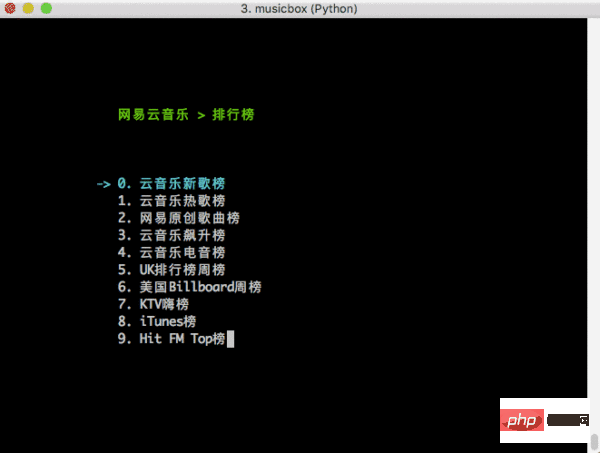 Backend Development
Backend Development
 Python Tutorial
Python Tutorial
 Complete collection of Python interface development libraries
Complete collection of Python interface development libraries
Complete collection of Python interface development libraries
curses

The built-in ncurses package is used to create a terminal graphical user interface. The curses library provides terminal-independent screen drawing and keyboard processing functions for text-based terminals. Now that graphical display interfaces are commonly used, interactive and more elegant terminals can be made in some niche markets, such as embedded Unix. Very nice.
enaml
enaml is a Python framework that allows you to implement high-quality GUI interfaces with minimal effort. It is also a unique programming language.
enaml combines a declarative language with a constraint-based layout system, allowing users to easily define flexible layouts of UI. enaml applications can run on any platform that supports Python and Qt.
enaml has the following features:
- A declarative programming language with Python style
- Dozens of widgets can be built directly on Qt
- Constraint-based layout engine (built on Kiwi)
- Integrated with data model tools (built on Atom)
kivy
Kivy is an open source The Python framework is used to quickly develop applications and implement various currently popular user interfaces, such as multi-touch and so on.
Kivy can run on most current mainstream desktop/mobile operating systems such as Windows, Linux, MacOS, Android, and iOS.
Kivy is based on Python and the design idea of separating interface files and program files from each other. The design is simple and elegant, the syntax is easy to learn, and it is suitable for newcomers to get started.
pyglet
A Python cross-platform window and multimedia library that can be used for game development, audio and video processing, etc. It is lighter than pygame.
PyQt
The Python binding of the cross-platform user interface framework Qt supports Qt v4 and Qt v5. This is a veteran interface design library.
PySide
The difference between PySide and PyQt is that the former is a product of the Qt company and the latter is a product of a third-party company. The usage of the two is basically the same, but there are big differences in the usage agreement. The difference is that PySide can be used under the LGPL license, while PyQt can be used under the GPL license.
Tkinter
Tkinter is a built-in GUI standard library of Python GUI. Its syntax is simple and easy to learn, suitable for beginners. Practice.
Toga
A Python-native, operating system-native GUI toolkit.
urwid
A library used to create terminal GUI applications, supporting components, events, rich colors, etc.

wxPython
wxPython is a cross-platform GUI toolkit for Python written in C, which allows Python programmers to simply and easily Program for creating powerful graphical user interfaces. It currently supports platforms including Microsoft Windows, Mac OS X and macOS, as well as Linux or other unix-like systems with GTK2 or GTK3 libraries.
PyGObject
PyGObject is a Python package that provides bindings for GObject-based libraries (such as GTK, GStreamer, WebKitGTK, GLib, GIO, etc.). These libraries can support the GTK 3 graphical interface toolset, so GObject provides a rich set of graphical interface components. It supports Linux, Windows and macOS.
Flexx
Flexx is a tool set written in pure Python language for creating GUI programs. It uses web technology to display the interface. The application is written entirely in Python, with the PScript translator dynamically generating the necessary JavaScript. Flexx can be used to create (cross-platform) desktop applications, web applications, and export applications to standalone HTML documents.
Eel
Eel is a lightweight Python library for making simple offline HTML/JS GUI applications similar to Electron (but more lightweight than it), and has the ability to Full access to Python capabilities and libraries.
Eel hosts a local web server and then allows you to annotate functions with Python so that they can be called from JavaScript and vice versa.
PySimpleGUI
It is a wrapper for tkinter, Qt, WxPython and Remi. By implementing most of the "boilerplate code", it is simpler and shorter than writing directly using the underlying framework. As you can tell from the name, it is easy to use, but not particularly beautiful in terms of appearance.
pywebview
pywebview is a lightweight cross-platform application container containing the WebView component, which can display HTML content in the native GUI window. Applying the power of Web technologies in desktop applications without the browser hiding the fact that the GUI is browser-based. You can use a lightweight web framework like Flask or Bottle with pywebview, or standalone with a two-way bridge between Python and the DOM.
DearPyGui
Dear PyGui is a simple to use (yet powerful) Python GUI framework. It is not a wrapper for Dear ImGui in the general sense, but a library built with Dear ImGui that emulates a traditional retained mode GUI (as opposed to Dear ImGui's direct mode paradigm). Dear PyGui is also fundamentally different from other Python GUI frameworks. Under the hood, Dear PyGui uses real-time mode paradigms and your computer's GPU to facilitate extremely dynamic interfaces. Dear PyGui currently supports the following platforms: Windows 10, macOs, Linux, Raspberry Pi 4.
EasyGUI
EasyGUI is a very simple and easy GUI programming module using Python. It is different from other GUI libraries because EasyGUI is not event-driven, instead all its GUI interactions are invoked through simple function calls and does not require the programmer to know anything about tkinter, frameworks, widgets, callbacks or lambdas .
The above is the detailed content of Complete collection of Python interface development libraries. For more information, please follow other related articles on the PHP Chinese website!

Hot AI Tools

Undresser.AI Undress
AI-powered app for creating realistic nude photos

AI Clothes Remover
Online AI tool for removing clothes from photos.

Undress AI Tool
Undress images for free

Clothoff.io
AI clothes remover

AI Hentai Generator
Generate AI Hentai for free.

Hot Article

Hot Tools

Notepad++7.3.1
Easy-to-use and free code editor

SublimeText3 Chinese version
Chinese version, very easy to use

Zend Studio 13.0.1
Powerful PHP integrated development environment

Dreamweaver CS6
Visual web development tools

SublimeText3 Mac version
God-level code editing software (SublimeText3)

Hot Topics
 Is the conversion speed fast when converting XML to PDF on mobile phone?
Apr 02, 2025 pm 10:09 PM
Is the conversion speed fast when converting XML to PDF on mobile phone?
Apr 02, 2025 pm 10:09 PM
The speed of mobile XML to PDF depends on the following factors: the complexity of XML structure. Mobile hardware configuration conversion method (library, algorithm) code quality optimization methods (select efficient libraries, optimize algorithms, cache data, and utilize multi-threading). Overall, there is no absolute answer and it needs to be optimized according to the specific situation.
 Is there any mobile app that can convert XML into PDF?
Apr 02, 2025 pm 08:54 PM
Is there any mobile app that can convert XML into PDF?
Apr 02, 2025 pm 08:54 PM
An application that converts XML directly to PDF cannot be found because they are two fundamentally different formats. XML is used to store data, while PDF is used to display documents. To complete the transformation, you can use programming languages and libraries such as Python and ReportLab to parse XML data and generate PDF documents.
 How to convert XML files to PDF on your phone?
Apr 02, 2025 pm 10:12 PM
How to convert XML files to PDF on your phone?
Apr 02, 2025 pm 10:12 PM
It is impossible to complete XML to PDF conversion directly on your phone with a single application. It is necessary to use cloud services, which can be achieved through two steps: 1. Convert XML to PDF in the cloud, 2. Access or download the converted PDF file on the mobile phone.
 What is the function of C language sum?
Apr 03, 2025 pm 02:21 PM
What is the function of C language sum?
Apr 03, 2025 pm 02:21 PM
There is no built-in sum function in C language, so it needs to be written by yourself. Sum can be achieved by traversing the array and accumulating elements: Loop version: Sum is calculated using for loop and array length. Pointer version: Use pointers to point to array elements, and efficient summing is achieved through self-increment pointers. Dynamically allocate array version: Dynamically allocate arrays and manage memory yourself, ensuring that allocated memory is freed to prevent memory leaks.
 How to control the size of XML converted to images?
Apr 02, 2025 pm 07:24 PM
How to control the size of XML converted to images?
Apr 02, 2025 pm 07:24 PM
To generate images through XML, you need to use graph libraries (such as Pillow and JFreeChart) as bridges to generate images based on metadata (size, color) in XML. The key to controlling the size of the image is to adjust the values of the <width> and <height> tags in XML. However, in practical applications, the complexity of XML structure, the fineness of graph drawing, the speed of image generation and memory consumption, and the selection of image formats all have an impact on the generated image size. Therefore, it is necessary to have a deep understanding of XML structure, proficient in the graphics library, and consider factors such as optimization algorithms and image format selection.
 How to convert xml into pictures
Apr 03, 2025 am 07:39 AM
How to convert xml into pictures
Apr 03, 2025 am 07:39 AM
XML can be converted to images by using an XSLT converter or image library. XSLT Converter: Use an XSLT processor and stylesheet to convert XML to images. Image Library: Use libraries such as PIL or ImageMagick to create images from XML data, such as drawing shapes and text.
 How to open xml format
Apr 02, 2025 pm 09:00 PM
How to open xml format
Apr 02, 2025 pm 09:00 PM
Use most text editors to open XML files; if you need a more intuitive tree display, you can use an XML editor, such as Oxygen XML Editor or XMLSpy; if you process XML data in a program, you need to use a programming language (such as Python) and XML libraries (such as xml.etree.ElementTree) to parse.
 Recommended XML formatting tool
Apr 02, 2025 pm 09:03 PM
Recommended XML formatting tool
Apr 02, 2025 pm 09:03 PM
XML formatting tools can type code according to rules to improve readability and understanding. When selecting a tool, pay attention to customization capabilities, handling of special circumstances, performance and ease of use. Commonly used tool types include online tools, IDE plug-ins, and command-line tools.





